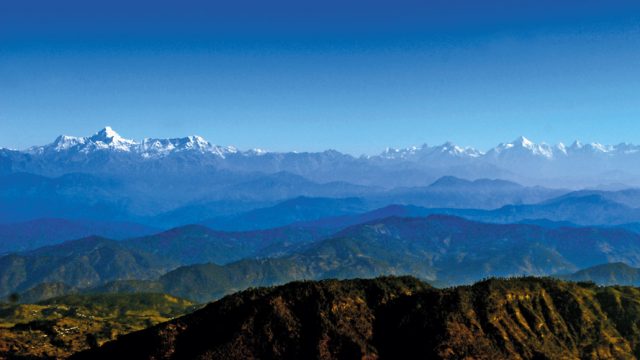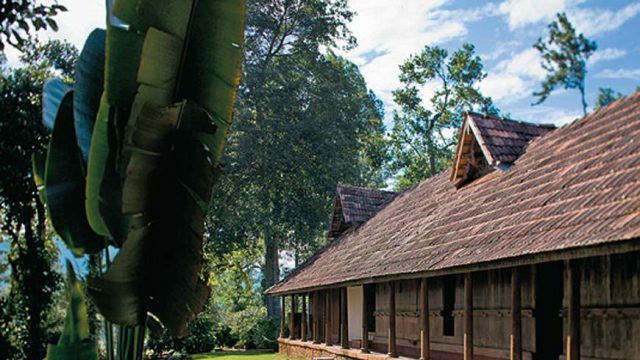A few years ago, Satri, a village near Binsar in the Uttarakhand foothills of the Himalayas, was
When I marched into Satri at the end of a three-day hike through the foothills arranged by Village Ways, the place was thriving. The men had come back from jobs in nearby towns to work as cooks, guides and porters, and the women, Satri’s greatest asset, smiled and joked with an easy, outgoing confidence they’ve acquired through managing the guesthouse the villagers built here two years ago. Money has rolled in as well. Sher Singh, the local guide who accompanied me and my photographer, was there to report that the village had earned Rs 72,000 from the tourist trade over the past two months. Neighbouring villages associated with the project, too, had earned upwards of Rs 60,000.
The reason is simple. The area surrounding Binsar, in the shadow of Nanda Devi, offers spectacular beauty. The pine forest is silent and deep, amid the evergreens, rhododendron bloom in a bloodflash of crimson, and on a clear day you can see the majestic snowcaps of the high peaks from the crest of nearly every rise. But the hills grow smaller every year. Once-sleepy hamlets like Binsar and Bhimtal are now chock-a-block with hotels, guesthouses and restaurants — most of them built, apparently, by blind bricklayers imported from some vast totalitarian state where the cinderblock is considered a work of art. Cars and trucks roar up and down the steep curves without a moment’s rest, and garish signs advertising multi-cuisine restaurants and Ayurvedic massage assault from all directions. A good rule of thumb: if you can drive to it, it’s already been ruined. Satri and other picturesque villages of the area like Kathdhara, Gonap, Risal and Dalar, which can only be reached on foot due to their location within the Binsar Sanctuary, are therefore the only unspoiled places left.
After waking up to a fine breakfast at the Khali Estate, a quaint, comfortable Raj-era resort that acts as a sort of base camp for Village Ways, Tribhuvan (our photographer) and I set out for our first day of walking. From a sunny spot on the road with a good view of the snowcaps, we dropped quickly down into the dark forest, following the lead of our guide, Sher Singh, a handsome man with a neat moustache. The ground was springy with moisture, but not wet, and there was an impressive silence. A mile or so along, a partridge broke cover and fluttered up beneath our feet, the startling whupwhup of its wings setting my heart going at the same rhythm. It was vigorous walking, mostly downhill, and, not surprisingly, the footing was good. Village Ways spent the better part of a year mapping and building these trails, to make them safe and navigable, of course, but also to create a network of paths that could facilitate tourists of different levels of fitness. “It wasn’t easy to make all these different routes,” Sher Singh told me. “But now we can walk from here to the village in one hour or in four hours, depending on the guest.” Naturally, we always took the shortest route.
We stopped at three of the five participating villages, Kathdhara, Gonap and Satri, each one smaller and more pleasant than the last. Coming into Kathdhara, we stopped on the trail above and looked down over the bright green terraces where the farmers were growing wheat, mustard, lentils and spinach in oval steps down the hillside. In another 20 minutes, we’d hiked down to the guesthouse, passing great piles of saffron-coloured pine needles, stacked like hay to dry for later use as kindling and bedding for livestock. We ate lunch beside a lemon tree with the Panchchuli range before us in the distance, spent a bit of time chatting with the locals, and then we marched on. In Gonap, we built a bonfire out of the football-sized Himalayan pine cones and watched the sunset, then ate a day-labourer’s enormous, starchy meal — dal, aloo gobhi, aloo tamatar, roti and rice — and sacked out.
The second day proved to be our longest walk — “We were trekking for three hours!” Tribhuvan exclaimed when he flopped down in a doorway at the end of it — and the most rewarding, because it ended in Satri. It’s no mystery why Satri is everybody’s favourite village. The place only has three families, but it’s like a factory for beautiful women, all of whom are constantly smiling and laughing. Apparently, though, whatever it is that makes the women beautiful and happy also makes people crazy (or maybe it’s not getting to marry one of the beautiful women?) because most of the houses in the village are empty. Before Village Ways started, bringing not only a source of income but also entertainment and a steady train of news and supplies, the few villagers left here thought they would have to abandon their homes and move to town. Thanks to Pande and his partners at Village Ways, that now looks unlikely to happen.
The key to making the Village Ways project sustainable was to make the villagers themselves the owners of the guesthouses, Dinesh Pande, a local activist who advised Village Ways on the project, told me. Burned once by the state and the forest department when their land was declared part of the Binsar Sanctuary, the local people would not have been keen to accept yet another domineering landlord. And the borrow-build-operate model that financed the construction of the guesthouses — Village Ways provided 40 percent of the money with a grant, 60 percent with an interest-free loan, and the villagers themselves did the building — gives them a much deeper commitment to the project.
The local end of management, too, is collaborative. Every village has a democratically elected Gram Paryatan Samiti (village tourism committee), and one member from each of these committees represents the village in a project-wide decision-making body called the Paryatan Vikas Samiti (tourism development committee). The Gram Paryatan Samitis supervised the construction of the five Village Ways guesthouses, which on the advice of their city-bred collaborators, were built by local craftsmen in the traditional style the villagers used for their own houses. Built with stone and mud mortar, the guesthouses have flush toilets and showers, but solar power provides electricity and hot water. Now, the Gram Paryatan Samitis manage the guesthouses’ day-to-day operation and finances — including making payments on the 10-year loan from Village Ways. The Gram Paryatan Samitis also administer a village development fund, which receives 20 percent of the guesthouse income and is used to finance projects that will benefit the entire community. The villagers welcome the results, I found when I chatted with residents of Kathdhara, Gonap and Satri. “Now, at least 25 percent of the migration out has stopped, and the only people who leave are those who get good jobs,” said 78-year-old Amar Singh, a retired policeman who lives in Gonap. “If we continue to get more tourists,” he said, “we might get a motorable road. We might get more development.”
For the duration of that day’s hike, I wondered whether the villages I was visiting were truly ‘sustainable’, and if Gonap was a rural paradise, or a people zoo. Then I walked into Satri, and Kiran, a teenaged village belle, garlanded me with a string of mustard flowers. Was there a flirtatious sparkle in her eye, I thought? Perhaps I am not so old after all. And so the fate of the countryside, fragile as it is, slipped easily from my mind. Fleeting, maybe, but this was paradise.
The information
Getting there
By rail: From Delhi, take the Ranikhet Express from Old Delhi railway station to Kathgodam (110km from Khali Estate), and arrange a taxi from there (Khali Estate can organise transfers on separate payment). From Mumbai, take the Punjab Mail to Agra or Mathura and transfer at either of those stations to the Kumaon Express. Get down at Lalkua (approx. 125km from Khali Estate) and take a taxi from there.
By road: From Delhi, take NH24 through Rampur, Pantnagar, Kathgodam, Bhimtal, Bhowali and Almora. Beyond Almora the route passes through Kasardevi and Kaparkhan to the Binsar Sanctuary gate. From there, it’s a short drive to Khali Estate.
The packages
Weekend getaway (3 nights): This package includes one night at Khali Estate and two nights in two of the five participating villages. The price includes all meals and guide fees, but any alcoholic drinks will be billed separately. You may also substitute an additional night in one of the villages for the night at Khali Estate. The amount of walking can be tailor-made to suit clients, with daily walks of between one and five hours.
Village Ways and Corbett (4nights): This package includes one night at Corbett National Park, where you will stay in tented accommodation at Corbett River Lodge, and three nights in three different villages. Walking times can be adjusted according to the guest’s desire and fitness level.
Weeklong getaway (7 nights): This package includes an overnight in each of the five villages and two nights at Khali estate. You may choose from two different itineraries, ‘beyond zero point’ or ‘ways and culture’. ‘Beyond zero point’ is a somewhat more intense walking holiday that takes you to the highest points of the region, including the famed ‘zero point’. Some of the treks involve more than six hours of walking over hilly terrain, at altitudes as high as 2,000m, so you need to be fit for this one. The routes follow footpaths and tracks, so no technical skill is needed, but there are some lengthy ascents and some scrambling is required here and there.‘Ways and culture’ is a more relaxed itinerary, with less emphasis on walking. You should be prepared for a couple hours of walking each day, but your routes will be as easy as possible in the hills and you will have more time to spend observing and participating in village life.
All the packages include all three meals at Khali and in the villages, the cost for the guides and porters offered to all our guests.
Contact
www.villageways.com
Kumaon
rural tourism
Leave a Reply
You must be logged in to post a comment.





